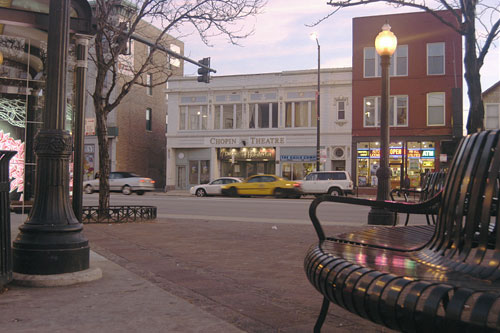
The Chopin Theatre
1541-43 West Division Street, Chicago
I’m sprinting down Milwaukee Avenue in Chicago, Illinois. It’s nearly two o’clock on a sunny April Saturday and show time for The Hammer Trinity plays, an epic nine-hour fantasy with puppetry, live music, fight choreography, and an explosive scenic design.
Two weeks later, I’m crossing the rain-drenched intersection of Milwaukee Avenue again, this time to attend a Brunch Salon with author Malgorzata Pospiech, who just published Miasteczko, a novel about the mysterious deaths of politically active Poles in the town of Kępno in the 1940s and 50s.
As exceptional as it may seem, both of these events happened at the same venue: The Chopin Theatre.
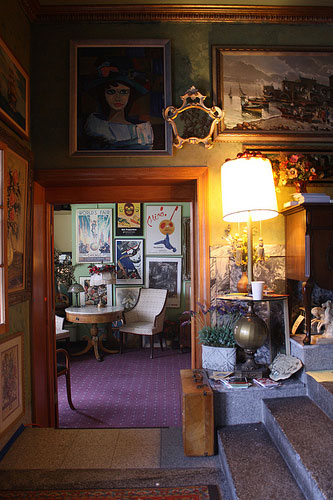
Chopin Theatre: East Wing Gallery
PHOTO: S. Kelleher
The nearly hundred-year-old building at 1541-43 West Division Street was built by John Konczyk and Sons Contractors in 1917-8 across from the plaza at the intersection of Milwaukee, Ashland and Division streets. The area, now called Wicker Park, was called “the Polish Triangle” because from 1860 to 1950 large numbers of Polish immigrants lived there; approximately 2 million of them began their American journey at these crossroads, also referred to as “Polish Broadway.” The neighborhood was home to four majestic churches and enormous Catholic parishes—St. Stanislaus Kostka (over 35,000 parishioners), Holy Trinity, St. Mary of the Angels, and St. John Cantius—and the largest Polish organizations: the Polish National Alliance, Polish Roman Catholic Union, Polish Museum of America, Polish Women’s Alliance, Daily Zgoda and many others. Polonia oral histories and articles in the Polish newspapers in the period attest to the popularity of the Chopin Theatre building in the 1910s and 20s: men played pool in the basement, patriots bought WWI Liberty Bonds from the box office, and people attended silent films and live theatre in the first floor main stage. Today some older-generation Polish-Americans remember the bakery next to the main entrance best.
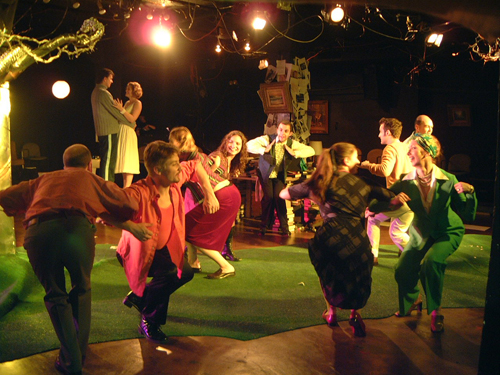
Uma Productions: “Why They Invented Dancing”
When Zygmunt Dyrkacz, a Polish immigrant and biologist-cum-entrepreneur, bought the building in 1990, the Chopin’s early heyday was long past. The dilapidated theatre was surrounded by vacant and vandalized buildings in Wicker Park, a neighborhood best known in the 70s and 80s for the gritty way writer Nelson Algren portrayed it in books Chicago: City on the Make, and Man with the Golden Arm. But bullets embedded on the building’s window and bricks didn’t deter Dyrkacz. As an advocate of the way art can inspire change and revolution, Dyrkacz saw the Chopin’s potential: “I wanted to change something. I don’t see theater as illustration, [I see] theater as a way to fight the power. And there were times in Poland where people would go on the stage and wanted to be relevant to social political discourse, and the next day their show would be closed. Also I fell in love with the neighborhood as much as the building.”
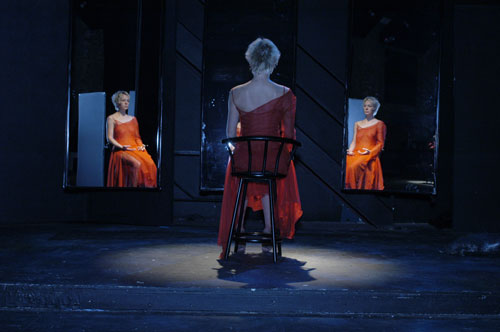
Teatr Cogitatur’s production of “Aztec Hotel”
In Chicago’s theatre community, everyone knows The Chopin and Dyrkacz, (or “Ziggy,” as he is affectionately called). Some of Chicago’s, and the world’s, most remarkable artists, theatre companies, and shows have happened there, including John Cusack and Jeremy Piven’s weed-induced adaptation of Hunter S. Thompson’s Fear and Loathing in Las Vegas (1991); Puppet Theatre Banialuka’s Opowiesc o chlopcu i wietrze, Jas i Malgosia (1994), David Cromer’s (a MacArthur Foundation “genius” grant fellow) Our Town for The Hypocrites (2008); Theater Oobleck’s An Apology…Delivered by Doctor John Faustus on This His Final Evening (2009); and Chicago’s most experimental theatre, Plastiscene’s, debut and final performances (in 1995 and 2012, respectively). These projects, like The House Theatre’s The Hammer Trilogy or The Hypocrite’s Sophocles Seven Sickenesses, each reflects Dyrkacz’s commitment to what he calls “performance theatre,” theatre that is intellectually and visually stimulating, controversial, and often anti-establishment and anti-war. The Chicago Tribune theatre critic, Chris Jones, listed the Chopin as one of Chicago’s world-class venues, “with kindly, theater-loving owners and great Polish beer at the bar,” it is a place that composes art of merit.
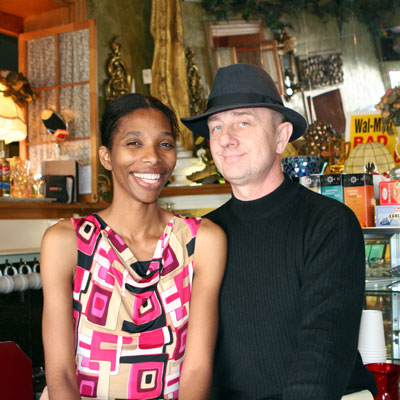
Lela + Zygmunt Dyrkacz
In his twenty-five years at the helm, Dyrkacz and his wife of fourteen years, business woman Lela Headd Dyrkacz, have brought about the Chopin Theatre’s renaissance. Now the building has two theatres, a café, an art gallery, and the Pregnant Buffalo Lounge. While they do produce theatre, the building could be more aptly called the Chopin Cultural and Performance Center. For example, such literary giants as Gwendolyn Brooks, Stuart Dybek, Aleksander Hemon, Yusef Komunyaka, Phillip Levine, Charles Simic, Zadie Smith and Studs Terkel, plus 70 great Polish artists have read or lectured there. The Dyrkaczs’ vision, tenacity, and personal labor have resulted in a beautifully rehabbed historic space that hosts 500+ events per year, events as diverse as American and world theatre, concerts, poetry readings, book signings, political rallies, academic conferences, film screenings, visual art exhibits, emerging artist festivals, and many more. And the Dyrkaczs receive no public funding to support their work. Nevertheless, the theatre’s incredibly detailed Archives on its website attests to their abundant and diverse programming, and the building serves as a space where people from different walks of life can encounter one another. At just the play and the book salon, I spoke with a librarian and cultural programmer for the Polish Museum of America, staff from the Polish Consulate in Chicago, professors from Polish Studies at Loyola University, a staff member from the Northern District Court of Illinois, a Latino theatre professor from Columbia College Chicago, five up-and-coming actors, a theatre costume designer, and many young students and artists.
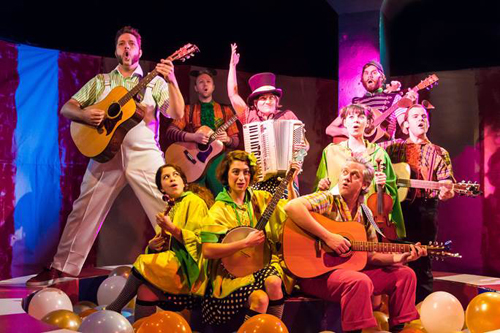
Hypocrites: “Mikado”
This diversity is matched by the evolving nature of the neighborhood. Experimental performance and edgy politics matched Wicker Park’s coarse atmosphere throughout the 1990s. But the neighborhood has changed. New multi-million-dollar buildings and upscale condos line the streets of Wicker Park, an area Forbes Magazine named one of the hippest neighborhoods in America in 2012 in America in 2012. In spite of the changes, however, the Chopin’s programming remains uncompromised. From a beacon of safety and sophistication during Wicker Park’s seedier times to a beacon of politically-conscious culture in the face of rampant consumerism, the Chopin Theatre continues to cultivate new work, incite change, and provide Chicago with an intersection to meet diverse, vibrant, worldly, and civically engaged people.
CR




Pingback: Welcome to Summer 2015!